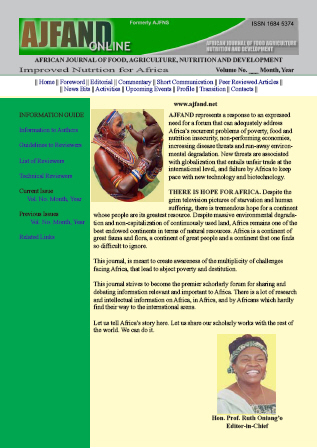
|
African Journal of Food, Agriculture, Nutrition and Development
Rural Outreach Program
ISSN: 1684-5358
EISSN: 1684-5358
Vol. 20, No. 3, 2020, pp. 15978-15991
|
 Bioline Code: nd20048
Bioline Code: nd20048
Full paper language: English
Document type: Research Article
Document available free of charge
|
|
|
African Journal of Food, Agriculture, Nutrition and Development, Vol. 20, No. 3, 2020, pp. 15978-15991
| en |
POSTHARVEST PRACTICES ALONG SUPPLY CHAINS OF SOLANUM AETHIOPICUM  (Shum) AND AMARANTHUS LIVIDUS (Shum) AND AMARANTHUS LIVIDUS  (Linn) LEAFY VEGETABLES IN WAKISO AND KAMPALA DISTRICTS, UGANDA (Linn) LEAFY VEGETABLES IN WAKISO AND KAMPALA DISTRICTS, UGANDA
Apolot, MG; Acham, H; Ssozi, J; Namutebi, A; Masanza, M; Kizito, E; Jagwe, J; Kasharu, A & Deborah, R
Abstract
A cross-sectional study design was employed for the purpose of understanding the postharvest practices and entry point for losses along the supply chains of Solanum aethiopicum and Amaranthus lividus leafy vegetables. This is important so that interventions along the supply chain may not be misplaced. The target population included chain actors: farmers (n=10), traders (n=30) and key informants (n=7) who were selected purposively for interviews. A total of 10 farms and 7 market visits were made along the two supply routes: Kabubbu-Kalerwe and Kabubbu-Kireka. Data were collected using a semi-structured questionnaire and key informant checklist. Two supply chains were observed in this study: short supply chain where the farmer doubled as a trader. Farmers in this category were the majority (90%). In the long type, farmers (10%) supplied middlemen/transporters who then delivered to the markets. Furthermore, there were no exports or value addition in either of the supply chains. A good hygiene practice observed on the farm was that of trimming off the roots of vegetables to reduce contamination from the soil and also the amount of garbage generated in the market. Packing of vegetables on hired trucks was a common practice where roots/leaves faced each other to prevent soiling of the leaves by the roots. The main transport means used was truck (100%) with alternative transportation means being motorcycle and bicycles. The cool evening hours (20:00 to 00:00hrs) were the most preferred transportation times. The packaging method observed in the market was use of either black or white polythene bags at the point of sale with only 53.3% of the traders packaging for their customers. There was no proper packaging and storage both on the farms and in the markets. Traders in the markets either sprinkled water on the leftover vegetables or covered them with a wet sack as a preservation method. Moreover, only 16.6% sorted and graded their vegetables whereas 83.4% did not. There was inappropriate handling, storage and packaging practices along the two supply chains.
Keywords
handling; transport; packaging; storage; leafy vegetables; supply chain; chain actors
|
| |
© Copyright 2020 - African Journal of Food, Agriculture, Nutrition and Development
Alternative site location: http://www.ajfand.net/
|
|
